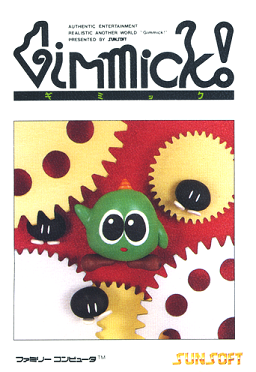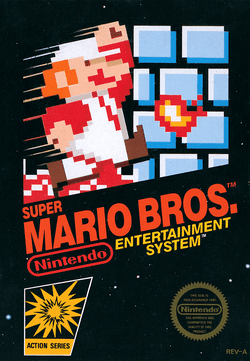
Nintendo Co., Ltd. is a Japanese multinational video game company headquartered in Kyoto. It develops, publishes and releases both video games and video game consoles.

Dr. Mario is a 1990 puzzle video game developed and published by Nintendo for the Nintendo Entertainment System, Famicom, and Game Boy. It was produced by Gunpei Yokoi and designed by Takahiro Harada. The soundtrack was composed by Hirokazu Tanaka.

Super Mario Bros. 3 is a 1988 platform game developed and published by Nintendo for the Nintendo Entertainment System (NES). It was released for home consoles in Japan on October 23, 1988, in North America on February 12, 1990 and in Europe on August 29, 1991. It was developed by Nintendo Entertainment Analysis and Development, led by Shigeru Miyamoto and Takashi Tezuka.

The Family Computer Disk System, commonly shortened to the Famicom Disk System, or just Disk System, is a peripheral for Nintendo's Family Computer home video game console, released only in Japan on February 21, 1986. It uses proprietary floppy disks called "Disk Cards" for cheaper data storage and it adds a new high-fidelity sound channel for supporting Disk System games.

The NES Zapper, also known as the Video Shooting Series light gun in Japan, is an electronic light gun accessory for the Nintendo Entertainment System (NES) and the Japanese Famicom. It was released in Japan for the Famicom on February 18, 1984, and launched alongside the NES in North America in October 1985.
In the history of video games, the third generation of video game consoles, commonly referred to as the 8-bit era, began on July 15, 1983, with the Japanese release of two systems: Nintendo's Family Computer and Sega's SG-1000. When the Famicom was released outside of Japan, it was remodeled and marketed as the Nintendo Entertainment System (NES). This generation marked the end of the video game crash of 1983, and a shift in the dominance of home video game manufacturers from the United States to Japan. Handheld consoles were not a major part of this generation; the Game & Watch line from Nintendo and the Milton Bradley Microvision that were sold at the time are both considered part of the previous generation due to hardware typical of the second generation.

The Nintendo VS. System is an arcade system that was developed and produced by Nintendo. It is based on most of the same hardware as the Family Computer (Famicom), later released as the Nintendo Entertainment System (NES). As Nintendo was planning to release the NES in North America, they were aware of the video game crash of 1983 and its effects on the home console market. However by March 1984 the arcade industry recovered enough for a plan to introduce NES titles there, with the VS. System later being a presentation to players who did not yet own the console. It became the first version of the Famicom hardware to debut in North America.
In video gaming, famiclone is a term used to refer to a hardware clone of the Nintendo Entertainment System (NES), known in Japan as the Family Computer or Famicom. They are designed to replicate the workings of, and play games designed for, the NES and Famicom. Hundreds of unauthorized clones and unlicensed game copies have been made available since the height of the NES popularity in the late 1980s. The technology employed in such clones has evolved over the years: while the earliest clones feature a printed circuit board containing custom or third party integrated circuits (ICs), more recent (post-1996) clones utilize single-chip designs, with a custom ASIC which simulates the functionality of the original hardware, and often includes one or more on-board games. Most devices originate in China and Taiwan, and less commonly South Korea. Outside China and Taiwan, they are mostly widespread across emerging markets of developing countries.

The Power Player Super Joy III is a line of handheld Nintendo Entertainment System/Famicom video game console clones. They are notable for legal issues based on the violation of intellectual property rights held by Nintendo and its various game licensees. Manufactured by Sinango, the Power Player line has been sold in North America, Brazil, Europe, Asia, and Australia.

The history of the Nintendo Entertainment System (NES) spans the 1982 development of the Family Computer, to the 1985 launch of the NES, to Nintendo's rise to global dominance based upon this platform throughout the late 1980s. The Family Computer or Famicom was developed in 1982 and launched in 1983 in Japan. Following the North American video game crash of 1983, the Famicom was adapted into the NES which was launched in North America in 1985. Transitioning the company from its arcade game history into this combined global 8-bit home video game console platform, the Famicom and NES continued to aggressively compete with next-generation 16-bit consoles, including the Sega Genesis. The platform was succeeded by the Super Famicom in 1990 and the Super Nintendo Entertainment System in 1991, but its support and production continued until 1995. Interest in the NES has been renewed by collectors and emulators, including Nintendo's own Virtual Console platform.
LCD games are electronic games played on an LCD screen. Since the release of the Zelda Game & Watch game in August 1989, several LCD games based upon the theme of The Legend of Zelda have been licensed by Nintendo to be released for both Japanese and foreign markets. While Zelda was both developed and manufactured by Nintendo, later LCD games would only be licensed by Nintendo. The Legend of Zelda game watch is an LCD wristwatch game produced by Nelsonic as part of their Nelsonic Game Watch series, and Zelda no Densetsu: Kamigami no Triforce is an LCD fighting video game licensed by Nintendo and produced by Epoch Co. for the Barcode Battler II platform, and released only in Japan.

Gimmick!, released in Scandinavia as Mr. Gimmick, is a platform video game developed and published by Sunsoft, and originally released in Japan for the Family Computer in 1992. The story follows a small green yōkai named Yumetaro who was mistakenly gifted as a toy to a young girl. After the girl's toys come to life and whisk the girl away to another dimension, Yumetaro gives chase to save her. Playing as Yumetaro, the player must maneuver through a variety of levels, using the protagonist's star-shooting power to defeat enemies and progress through the game.

Nintendo Mini Classics are a series of small LCD games licensed by Nintendo in 1998. Most games in the series are reissues of Game & Watch titles, but the series does include titles that were not from the original Game & Watch line, like Spider-Man, Carrera and Yu-Gi-Oh!.

The Japanese multinational consumer electronics company Nintendo has developed seven home video game consoles and multiple portable consoles for use with external media, as well as dedicated consoles and other hardware for their consoles. As of September 30, 2021, in addition to Nintendo Switch, Nintendo has sold over 863.07 million hardware units.

The Nintendo Entertainment System (NES) is an 8-bit third-generation home video game console produced by Nintendo. It was first released in Japan in 1983 as the Family Computer (FC), commonly referred to as Famicom. It was redesigned to become the NES, which was released in American test markets on October 18, 1985, and was soon fully launched in North America and other regions.

The Game & Watch is a line of handheld electronic games created by Nintendo. Released from 1980 to 1991, these devices were the brainchild of designer Gunpei Yokoi. Their name reflects their dual functionality: a single game paired with a digital clock on an LCD screen. Starting in 1981, models also included an alarm.

Super Mario Bros. is a platform game developed and published in 1985 by Nintendo for the Famicom in Japan and for the Nintendo Entertainment System (NES) in North America. It is the successor to the 1983 arcade game Mario Bros. and the first game in the Super Mario series. Following a US test market release for the NES, it was converted to international arcades on the Nintendo VS. System in early 1986. The NES version received a wide release in North America that year and in PAL regions in 1987.
Zoink AB was a Swedish video game developer based in Gothenburg. The company was founded by Klaus Lyngeled in 2001 and formed the Thunderful group with Image & Form in 2017. In 2020, Zoink was integrated into Thunderful Development.
Thunderful Group AB is a Swedish video game holding company based in Gothenburg. It was founded in December 2019 through a merger between Thunderful AB and Bergsala Holding's distribution business, consisting of Bergsala, Amo Toys, and Nordic Game Supply. The former Thunderful had been founded in December 2017 between Bergsala Holding, Brjánn Sigurgeirsson, and Klaus Lyngeled, incorporating Sigurgeirsson and Lyngeled's indie game studios—Image & Form and Zoink—and acquiring the publisher Rising Star Games from Bergsala Holding in July 2018. Thunderful Group has since acquired further developers, the publisher Headup Games, and the consultancy firm Robot Teddy.

The Nintendo Entertainment System (NES), an 8-bit third-generation home video game console produced by Nintendo, had numerous model variants produced throughout its lifetime. It was originally released in 1983 as the Family Computer in Japan, with design work led by Masayuki Uemura. Nintendo intentionally redesigned it as the NES in North America in an attempt to avoid the stigma of video game consoles lingering from the video game crash the same year; while it was initially conceptualized as a home computer, it was ultimately modeled after a videocassette recorder (VCR) for its debut there in 1985. Nintendo subsequently exported the NES to Europe and Oceania via local distributors.















